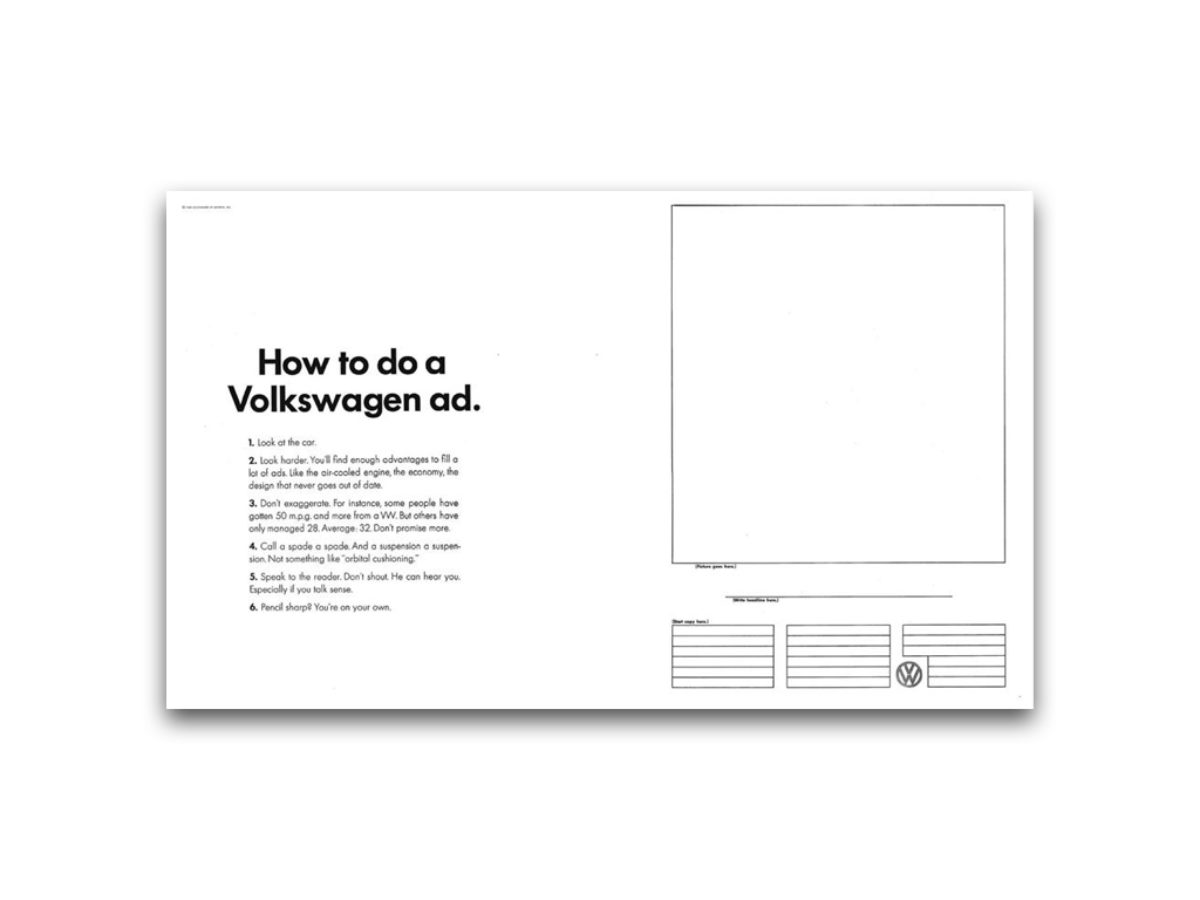Simple branding: don’t knock it ’till you try it.
In the 1950’s and 60’s, Volkswagen’s brand advertising was the talk of the town. Contrary to the ad zeitgeist (More! Better!) the VW ads engaged readers with humble, common sense propositions. Best of all, they weren’t afraid to poke fun at their product’s shortcomings – the Beetle’s size and queer shape provided the fodder for dozens of brilliant ads.
More than anything else, however, VW’s ads were remarkable in their simplicity. Virtually every ad offered up a black and white image (usually the car on a white background), a few paragraphs of copy, and a headline in plain type. Nothing more.
This wasn’t a fluke. In fact, the VW philosophy of simple honesty was enshrined in the ad you see here – partly a missive to the writers and art directors working on the account, partly proof to consumers that there was no hidden agenda, no subliminal seduction at work.
If these ads were so powerful, why didn’t they lead to a sea change in communications? Today, the majority of marketing messages are still a cluttered mess. And simple ads for brands like Apple and The Economist remain the exception, not the rule.
The truth is, simple branding is hard.
It isn’t impossible, though. To help you create better, simpler messages, I’ve put together a few pointers that have worked for me. Hope they help!
Simple branding starts with a single-minded brand proposition
Anyone who has gotten into a bun fight with a client over matters of taste in an ad can attest to this. You need to move the conversation upstream where you can defend your choices based on strategy, not personal preference.
The first step: get consumers to tell you what single thing they find most important, newsworthy, or attractive about your brand.
Imagine if the VW creative team had pitched the Lemon ad with nothing but ‘we like it’ as their defence. No dice.
In reality, they understood their consumer – these were people who weren’t buying Detroit’s overinflated claims, and who thought VWs were built by awkward, painfully honest, humorless German engineers. Suddenly, the Lemon ad seems a natural.
Message creep destroys simple branding
An ad is like a showroom window: it looks best with less. Unfortunately, that looks a lot like wasted real estate from an insider’s perspective.
It’s all too easy to let little extras creep into the message with each round of revisions. But each addition actually subtracts from the ad’s single-minded focus.
(Is your ad getting lost in the shuffle? Here are seven reasons this might be happening.)
Imagine VW’s Think Small ad. A tiny car in the top left corner. 3/4 of the ad left absolutely blank. How easy would it have been to add a coupon? Or call outs pointing out all the features? Or or or… ?
Certainly, it would’ve felt more like a judicious use of media dollars. But consumers wouldn’t have known where to focus their attention. And they certainly wouldn’t have remembered the message – that smaller cars are better than big.
Simple branding is hard work
Simple branding involves hard work up front. Instead of coming up with one idea to solve the problem, generate 20 (check out my Mini Marketing Moment on Thinking Inside The Box for a how-to guide on drawing up ideas). Then, road test these ideas on a disinterested audience (check this Mini Marketing Moment on Peer Review for the how-to). In my experience, the disinterested audience generally goes for the simple solution.
Armed with this information (and video testimonials, if need be), present a few of your top contenders to the client. I like to start with an outrageous solution to anchor the upcoming ideas (Well, that was crazy, but these look much more reasonable!). It’s probably safe to throw in a cluttered idea – with the accompanying dialogue on why your audience didn’t like it. Finally, get to your winner.
(Want to take simple branding in a new direction? How about using it to create the best video introduction ever?)
Done properly, your client will align with your test group. And even if not, they’ll have a tough time arguing against your strategy and single-minded focus. Arguments will sound subjective and not terribly convincing.
The result may not be another VW campaign. But it will be moving the ball in the right direction.
Is your brand simple, and compelling enough? A brand audit is a quick barometer of these, and other issues. You can book a free audit with me by clicking here.
Sign up for my newsletter below, to get my insights straight to your inbox.
Finally, don’t forget to share this story!
This post was first published in 2017. It was updated in 2022 just for you.



